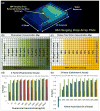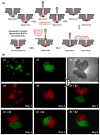384 hanging drop arrays give excellent Z-factors and allow versatile formation of co-culture spheroids
- PMID: 22161651
- PMCID: PMC3306496
- DOI: 10.1002/bit.24399
384 hanging drop arrays give excellent Z-factors and allow versatile formation of co-culture spheroids
Abstract
We previously reported the development of a simple, user-friendly, and versatile 384 hanging drop array plate for 3D spheroid culture and the importance of utilizing 3D cellular models in anti-cancer drug sensitivity testing. The 384 hanging drop array plate allows for high-throughput capabilities and offers significant improvements over existing 3D spheroid culture methods. To allow for practical 3D cell-based high-throughput screening and enable broader use of the plate, we characterize the robustness of the 384 hanging drop array plate in terms of assay performance and demonstrate the versatility of the plate. We find that the 384 hanging drop array plate performance is robust in fluorescence- and colorimetric-based assays through Z-factor calculations. Finally, we demonstrate different plate capabilities and applications, including: spheroid transfer and retrieval for Janus spheroid formation, sequential addition of cells for concentric layer patterning of different cell types, and culture of a wide variety of cell types.
Copyright © 2011 Wiley Periodicals, Inc.
Figures





References
-
- Friedrich J, Ebner R, Kunz-Schughart LA. Experimental anti-tumor therapy in 3-D: spheroids- old hat or new challenge. Int J Radiat Biol. 2007;83:849–871. - PubMed
-
- Friedrich J, Seidel C, Ebner R, Kunz-Schughart LA. Spheroid-based drug screen: considerations and practical approach. Nat Protoc. 2009;4:309–324. - PubMed
Publication types
MeSH terms
Grants and funding
LinkOut - more resources
Full Text Sources
Other Literature Sources

